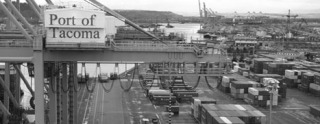The Ports of Seattle and Tacoma yesterday announced the results of a study that quantifies the carbon footprint of containers coming through the Puget Sound. According to the study, the lowest emission route to ship cargo from Asia to the U.S. Midwest is through the Puget Sound – the “Green Gateway” for trade.
The study, commissioned by the Port of Seattle, was conducted by Herbert Engineering, a ship design, engineering and transportation consulting firm based in California. They analyzed carbon footprints of trade routes between Singapore, Hong Kong and Shanghai, and the U.S. distribution hubs of Chicago, Columbus and Memphis as well as routes that use U.S. East and Gulf Coast ports via the Panama and Suez canals.
For ports of origin as far south as Singapore, carbon emissions for cargo moving by ship to the Pacific Northwest and by rail to a broad swath of the United States are lower than on routes through the Panama Canal, Norfolk, New York and California, according to the study.
Prior to its release, the Port of Seattle had Herbert Engineering’s study independently reviewed, and also asked trade experts, customers and shipping partners to review the results.
Greg Shelton, Managing Director of the Global Trade, Transport, and Logistics Studies program at the University of Washington, noted that within the study’s assumptions, the findings are good news for the Puget Sound. “I feel that the study shows that the West Coast and especially the Puget Sound have a lower carbon footprint for transporting goods between Asia and consumers in the heart of the U.S.,” Shelton remarked.
The carbon study follows on the Puget Sound Maritime Air Emissions Inventory, a study measuring how port activities affect regional air quality, and the Northwest Ports Clean Air Strategy.
For more information, visit http://www.portseattle.org/seaport/cargo/GreenGateway.shtml .






